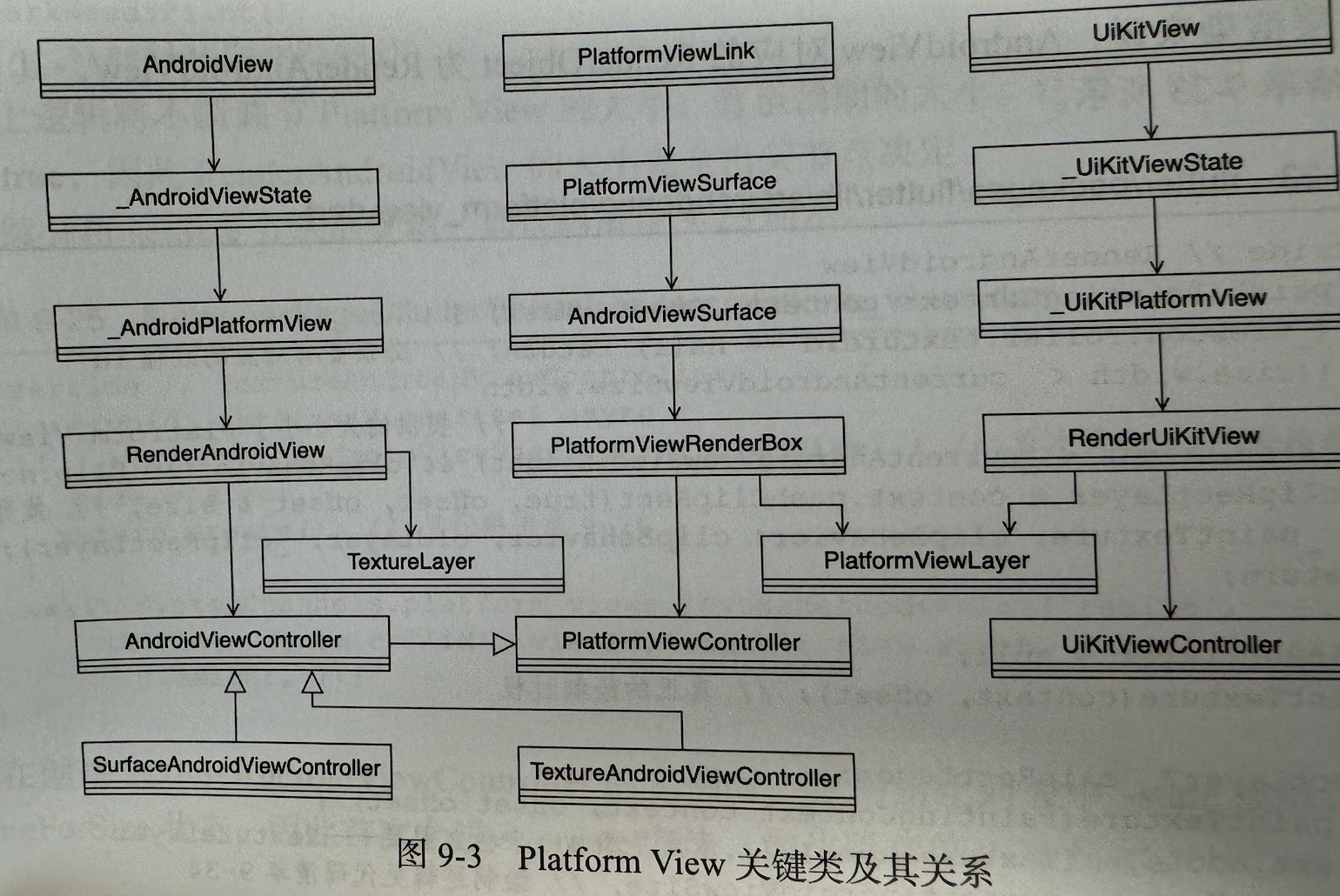
AndroidView、PlatformViewLink、UiKitView是表示Platform View的Widget接口,它们底层分别对应的RenderObject是RenderAndroidView、PlatformViewRenderBox、RenderUiKitView,前者基于TextureLayer进行真正的绘制,后两者给予PlatformViewLayer进行绘制。使用TextureLayer方式被称为Virtual Display,仅Android支持。使用PlatformViewLayer被称为Hybrid Composition,Android和iOS都支持。PlatformViewController和UiKitViewController时对Platform View中使用的Platform Channel的抽象封装,用于控制Platform View在Embedder中的各种属性和表现。
Virtual Display原理分析
1
2
3
4
5
6
7
| Widget build(BuildContext context) {
return AndroidView(
viewType: 'webview',
createionParams: xx,
createionParamsCodec: StandardMessageCodec(),
);
}
|
AndroidView对应RenderObject是RenderAndroidView
1
2
3
4
5
6
7
8
9
10
11
12
13
14
15
16
17
18
19
20
21
22
23
24
25
26
27
28
29
30
31
32
33
| class RenderAndroidView {
void paint(PaintingContext context, Offset offset) {
if (_viewController.textureId == null || _currentTextureSize == null) {
return;
}
final bool isTextureLargerThanWidget = _currentTextureSize!.width > size.width ||
_currentTextureSize!.height > size.height;
if (isTextureLargerThanWidget && clipBehavior != Clip.none) {
_clipRectLayer.layer = context.pushClipRect(
true,
offset,
offset & size,
_paintTexture,
clipBehavior: clipBehavior,
oldLayer: _clipRectLayer.layer,
);
return;
}
_clipRectLayer.layer = null;
_paintTexture(context, offset);
}
void _paintTexture(PaintingContext context, Offset offset) {
if (_currentTextureSize == null) {
return;
}
context.addLayer(TextureLayer(
rect: offset & _currentTextureSize!,
textureId: _viewController.textureId!,
));
}
}
|
Virtual Display方案存在一些问题,比如无法响应复杂的手势。于是出现了Hybrid Composition
Hybrid Composition原理分析
1
2
3
4
5
6
7
8
9
10
11
12
13
14
15
16
17
18
19
20
21
22
23
24
25
26
27
28
29
| Widget build(BuildContext context) {
const String viewType = '<platform-view-type>';
const Map<String, dynamic> creationParams = <String, dynamic>{};
return PlatformViewLink(
viewType: viewType,
surfaceFactory: (context, controller) {
return AndroidViewSurface(
controller: controller as AndroidViewController,
gestureRecognizers: const <Factory<OneSequenceGestureRecognizer>>{},
hitTestBehavior: PlatformViewHitTestBehavior.opaque,
);
},
onCreatePlatformView: (params) {
return PlatformViewsService.initSurfaceAndroidView(
id: params.id,
viewType: viewType,
layoutDirection: TextDirection.ltr,
creationParams: creationParams,
creationParamsCodec: const StandardMessageCodec(),
onFocus: () {
params.onFocusChanged(true);
},
)
..addOnPlatformViewCreatedListener(params.onPlatformViewCreated)
..create();
},
);
}
|
PlatformViewLink对应RenderObject时PlatformViewRenderBox
1
2
3
4
5
6
7
8
9
10
11
12
13
14
15
16
17
18
19
20
21
22
23
| class PlatformViewRenderBox {
void paint(PaintingContext context, Offset offset) {
context.addLayer(PlatformViewLayer(
rect: offset & size,
viewId: _controller.viewId,
));
}
}
class _PlatformViewLinkState {
void _initialize() {
_id = platformViewsRegistry.getNextPlatformViewId();
_controller = widget._onCreatePlatformView(
PlatformViewCreationParams._(
id: _id!,
viewType: widget.viewType,
onPlatformViewCreated: _onPlatformViewCreated,
onFocusChanged: _handlePlatformFocusChanged,
),
);
}
}
|
Hybrid Composition的流程和Virtual Display相差很大,下面从Engine和Embedder两个阶段进行分析
Engine处理阶段
Flutter的UI最终绘制于Raster线程,而Hybrid Composition模式下的Platform View是原生View,需要绘制于Platform线程,由于两者需要同帧绘制,因此Flutter会做出牺牲,将自身UI也通过Platform线程进程绘制。
Embedder处理阶段
- 将当前用于渲染Flutter UI的FlutterSurfaceView转换为FlutterImageView,Hybrid Composition模式下将使用后者渲染Flutter UI
参考
